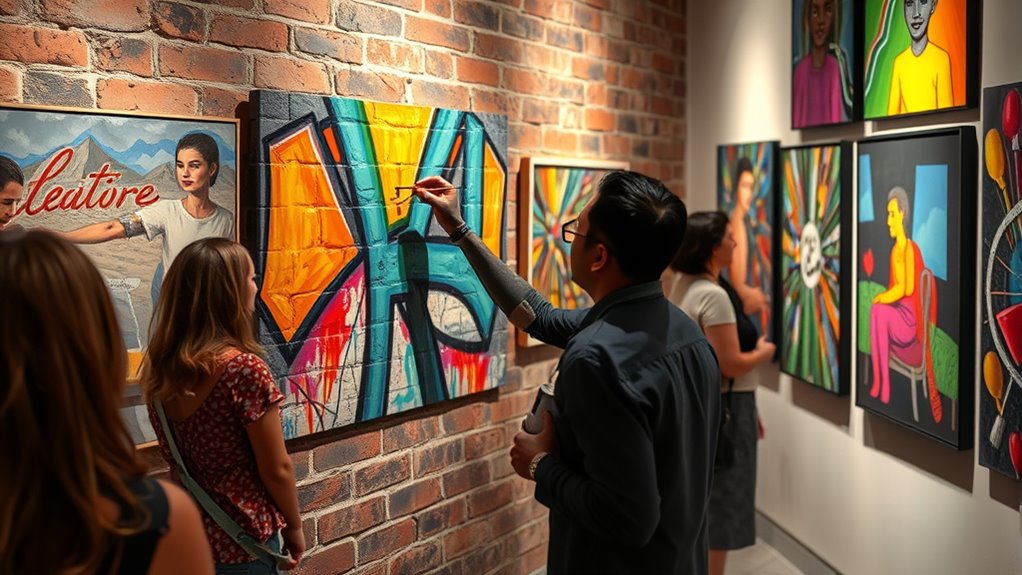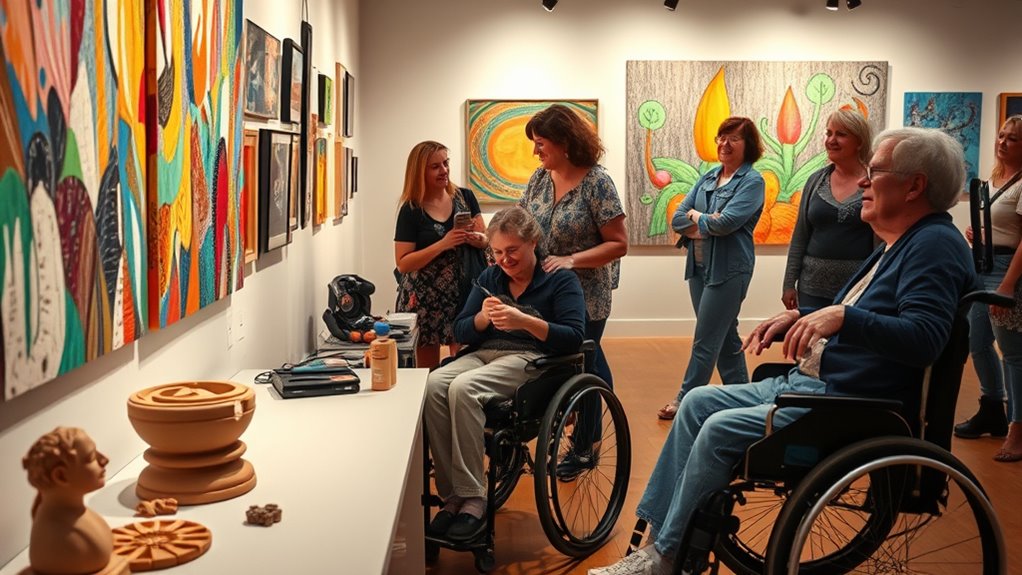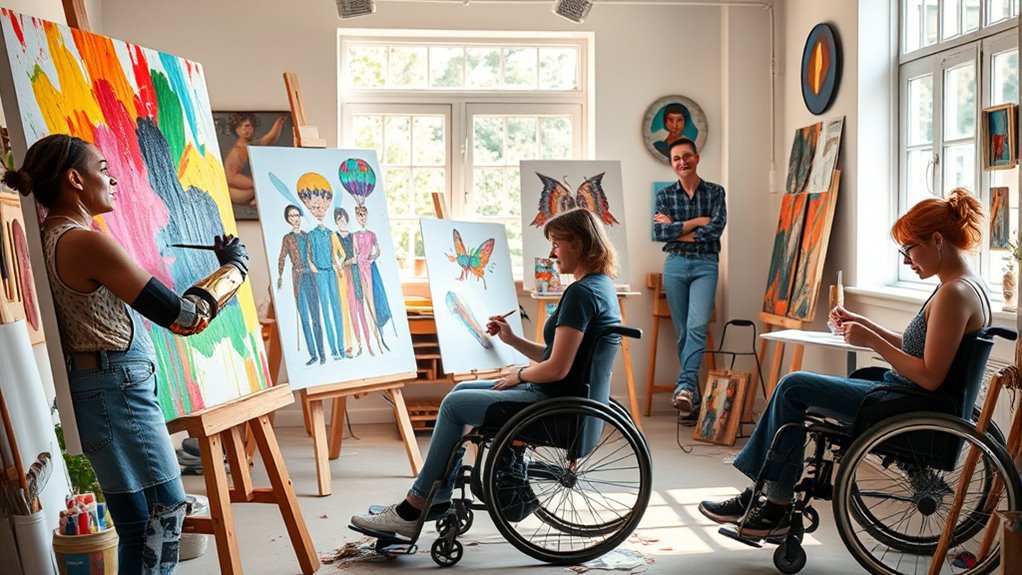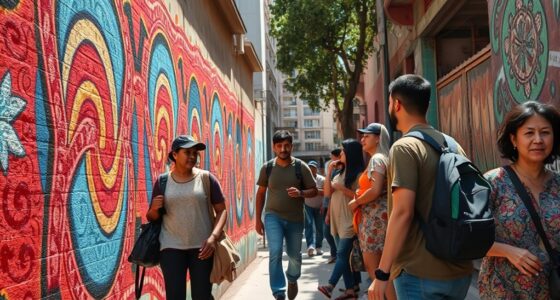Disability in art highlights the talents and resilience of artists with disabilities, challenging stereotypes and expanding inclusive creative spaces. You’ll see how technological innovations and accessible design make art more engaging for diverse audiences. Recognition of these artists also promotes social change, breaking down barriers and fostering community. If you explore further, you’ll discover inspiring stories of empowerment, inclusive policies, and how supporting these artists transforms the cultural landscape.
Key Takeaways
- Celebrating artists with disabilities highlights their unique perspectives and challenges stereotypes, promoting inclusive representation in the art world.
- Inclusive creativity involves accessible design, adaptive technologies, and supportive infrastructure to foster participation for all artists and audiences.
- Technological innovations like AI and assistive tools empower disabled artists to explore new mediums and express their identities freely.
- Advocacy and policy efforts address economic disparities, improve funding, and create supportive environments for disabled artists’ growth.
- Building diverse, inclusive communities and raising awareness challenge societal biases, fostering acceptance and enriching artistic narratives.
Understanding the Prevalence of Disabilities in Artistic Communities

Understanding how common disabilities are within artistic communities is essential for fostering inclusive environments. Globally, about 18% of the Australian population has a disability, highlighting how prevalent these conditions are. In the U.S., developmental disabilities affect roughly 15% of children, and educational factors influence arts participation among adults with disabilities. Across regions, disability prevalence varies markedly, yet data on artists with disabilities remains limited. Many individuals with disabilities are interested in engaging with the arts, but physical barriers often prevent attendance at events. Despite this interest, only a small percentage of venues support work by disabled artists, and professional inclusion remains low. Recognizing these statistics underscores the importance of creating more accessible, supportive spaces for artists with disabilities worldwide. Additionally, implementing AI technologies can play a significant role in enhancing accessibility and inclusion in the arts sector. For example, advances in adaptive tools can help remove physical barriers, making artistic participation more feasible for a broader range of individuals. Furthermore, leveraging machine learning algorithms can help tailor resources and support systems to better meet the diverse needs of artists with disabilities, fostering a more inclusive arts community. Incorporating assistive technologies can also empower artists with disabilities to express their creativity more freely and effectively.
Overcoming Barriers to Participation and Inclusion

You can help break down barriers by ensuring venues are accessible and removing physical obstacles that prevent participation. Challenging negative attitudes and stereotypes is equally important to create a welcoming environment for all artists and audiences. When you focus on inclusive infrastructure and mindset shifts, you open doors for more meaningful participation in the arts. 88% of disabled musicians have experienced discrimination based on their disability, highlighting the urgent need for ongoing efforts to foster true inclusivity. Promoting accessible art spaces can significantly enhance participation and visibility for artists with disabilities. Incorporating specialized custodial services can help maintain secure and welcoming environments that support diverse artistic expression. Additionally, understanding credit card security measures can help organizations protect sensitive data within inclusive venues.
Accessible Venues and Infrastructure
Accessible venues and infrastructure play a vital role in removing barriers that prevent individuals with disabilities from fully participating in the arts. With over 150,000 museums worldwide, many can be adapted for accessibility, especially through renovations and adaptive reuse. Incorporating physical features like ramps, elevators, and accessible restrooms ensures mobility needs are met. Sensory considerations, such as quiet spaces and sensory-friendly areas, help visitors with sensitivities. Technology, including audio descriptions and sign language interpretation, enhances experiences. Flexible seating and community involvement in design ensure venues meet diverse needs. Despite funding challenges, prioritizing accessibility and leveraging grants or partnerships can improve infrastructure. Well-designed, inclusive venues foster vibrant communities, encouraging participation and enriching cultural life for all. Additionally, understanding essential oils and their benefits can help create more comfortable and therapeutic environments within accessible spaces.
Challenging Attitudinal Barriers
Attitudinal barriers and preconceptions often prevent artists with disabilities from gaining equal opportunities and recognition in the arts sector. You might encounter negative stereotypes, such as being seen as safety risks, despite evidence showing your safety records are often just as good or better than those of non-disabled peers. Many arts organizations don’t actively seek out or involve disabled artists, with 31% not pursuing new work from you and 87% not including you in planning. Discrimination and lower career progression persist, reflecting systemic biases. Overcoming these barriers requires challenging assumptions, promoting awareness, and fostering inclusive attitudes. When you’re supported and included, the arts become richer, and your unique perspectives can truly flourish. Research shows that only 28% of venues and festivals regularly support work by disabled artists, highlighting the urgent need to challenge these persistent attitudinal barriers. Recognizing the importance of inclusive practices and actively working to implement them can help break down these harmful stereotypes and create a more equitable arts environment. Incorporating accessible design in exhibitions and performances can further encourage participation and visibility for disabled artists. Understanding and applying security principles from cybersecurity can also inform best practices in safeguarding inclusive initiatives and community engagement efforts. Additionally, fostering collaborative opportunities can help bridge gaps and promote greater integration of disabled artists into mainstream art spaces.
Economic Challenges Faced by Artists With Disabilities

Artists with disabilities face significant economic challenges that hinder their ability to sustain a livelihood through their creative work. Many lack adequate financial support, with 73% of disabled musicians not receiving benefits, and only 17.9% of disabled individuals employed. You often earn far less—about $144 monthly from art—making it hard to cover living costs. Despite these struggles, over 62% work full-time in art, yet face barriers like:
Artists with disabilities often struggle with low income and limited support, making sustainable careers challenging.
- Limited funding and grants, which force tough choices between creative support and living allowances.
- Irregular, low income that hampers financial stability.
- Reduced benefits when earning from art, often discouraging continued creative efforts.
Disability-related financial disparities further exacerbate these difficulties, making it even more challenging to achieve economic stability. These factors combine to create a cycle of financial instability, making it difficult for you to thrive as a disabled artist. Additionally, the lack of comprehensive social safety nets leaves many without adequate fallback options during periods of financial hardship. Recognizing the economic challenges faced by artists with disabilities is crucial to developing better support systems and fostering inclusive creative communities. Understanding how access to adaptive technologies and support services can improve economic outcomes is also essential for creating equitable opportunities in the arts sector. Promoting targeted financial assistance programs specifically for disabled artists could significantly improve their ability to sustain their careers and contribute diverse perspectives to the arts.
Representation and Identity: Shaping Artistic Narratives

While economic hurdles often limit disabled artists’ opportunities, the way disability is represented and shaped within artistic narratives plays a *vital* role in transforming societal perceptions. Art now challenges outdated stereotypes, emphasizing identity and lived experience rather than spectacle or pity. You can see this shift in works that reinterpret historical figures or explore embodiment, fostering empathy and understanding. Collaboration with non-disabled artists broadens inclusive storytelling, dismantling stereotypes like fear or curiosity. These narratives serve as powerful tools for social justice, advocating for accessibility and equal representation. Recognizing the importance of Prophetic Dreams in understanding cultural and spiritual contexts can further deepen the interpretive layers of such inclusive art. Additionally, attention to attention in creative practice enhances the depth and authenticity of these representations. Incorporating accessible design principles ensures that art remains inclusive and engaging for diverse audiences, reinforcing the message of equality and understanding.
The Creative Power of Disability: Inspiring Innovation

Disability often serves as a catalyst for innovation in the arts, inspiring new forms, techniques, and perspectives. When you explore the work of artists with disabilities, you see how they pioneer groundbreaking art by:
Artists with disabilities transform challenges into innovative art forms and fresh perspectives.
- Developing innovative mediums and pushing traditional boundaries, expanding artistic possibilities.
- Bringing diverse perspectives that challenge mainstream narratives and enrich themes of identity and community.
- Driving technological advancements, creating accessible tools and platforms that facilitate creative expression and global sharing.
These artists transform challenges into opportunities for growth, resilience, and originality. Their problem-solving skills and collaborative approaches foster inventive solutions, inspiring others to see limitations as catalysts for change. In doing so, they redefine what’s possible in the world of art.
Building Support Systems and Opportunities for Growth

Building effective support systems is essential to fostering growth and participation for people with disabilities in the arts. Without extensive data, it’s difficult to identify gaps or measure progress. Physical and systemic barriers, like inaccessible venues and attitudinal obstacles, limit opportunities. Access to training remains scarce, hindering skill development for many artists. Employment rates for disabled individuals are markedly lower than for non-disabled peers, reflecting broader systemic issues. Increasing public awareness can ignite a stronger disability arts movement, empowering artists and audiences alike. To support growth, targeted funding and improved accessibility are crucial. Collaboration between arts organizations and disability groups, along with tailored education programs, can create more inclusive environments. These efforts help build a foundation where artists with disabilities can thrive creatively and professionally.
The Role of Advocacy and Policy in Fostering Inclusion

You can see how policy changes that improve access, funding, and support are vital for fostering inclusion of disabled artists. Advocacy campaigns play a vital role in raising awareness and driving these policy shifts, ensuring disabled artists gain more opportunities. By pushing for transparent data and targeted initiatives, you help create a more equitable arts landscape for everyone.
Policy Changes for Access
How have advocacy efforts transformed policies to improve access in the arts? They’ve driven significant changes at local, national, and international levels. Advocacy groups like Americans for the Arts and Disability Arts International push for better data collection, increased visibility, and inclusive practices. Their campaigns highlight barriers faced by disabled artists and gather direct input from communities. These efforts have led to:
- More accessible venues and programming adjustments
- Inclusive hiring practices becoming standard
- Policies that prioritize proactive accessibility measures
While gaps remain—such as weak enforcement and regional disparities—advocacy continues to shape laws and standards. As a result, participation and visibility of disabled artists grow, fostering a more inclusive and diverse cultural landscape.
Funding and Support Initiatives
Advocacy and policy efforts play a crucial role in securing funding and support for disabled artists, helping to foster greater inclusion in the arts. You’ll see increased investments, like the Arts Council England boosting funding from over £2 million in 2015/16 to over £11 million in 2020/21, showing growing recognition. Grant programs, such as the Disability Futures Fellowship, support artists at the intersection of arts and social justice, while flexible grants paired with tailored assistance enable more effective support. Despite progress, disability-related grants still represent only 2% of foundation giving, highlighting the need for increased backing. Advocacy’s influence also extends to shaping policies and engaging communities, ensuring that funding initiatives promote visibility, accessibility, and inclusivity within diverse arts sectors.
Advocacy Campaign Strategies
What strategies do advocates use to promote inclusion in the arts for disabled communities? You play a essential role in shaping change through targeted actions. First, you push for legislation that enforces accessibility standards in venues, ensuring physical and sensory inclusion. Second, you advocate for policies that support the representation of disabled artists in exhibitions and commissions, increasing visibility. Third, you collaborate with disability organizations and arts councils to strengthen policy frameworks and accountability. These efforts legitimize disability inclusion, influence national cultural agendas, and foster equitable access. By engaging communities directly, hosting educational events, and using accessible communication, you amplify authentic voices. Your strategic advocacy creates systemic change, making the arts more inclusive and representative of diverse disability experiences.
Celebrating Diverse Voices and Expanding Inclusive Creativity

Celebrating diverse voices in art means actively creating spaces where disabled artists can showcase their talents and challenge traditional norms. Despite data gaps, the 18% of Australians with disabilities suggest significant representation potential. Platforms like the 2025 ArtAbility event and venues hosting disabled artists’ work elevate visibility and foster inclusion. Organizations such as Unlimited support innovation by commissioning disabled artists, broadening creative boundaries. Recognizing these efforts encourages societal change and challenges stereotypes that hinder access and opportunity.
| Barriers Faced | Opportunities Created |
|---|---|
| Physical access issues | Accessible exhibitions and training programs |
| Attitudinal stereotypes | Changing perceptions through visibility |
| Funding gaps | Increased support and advocacy efforts |
| Intersectional challenges | Building inclusive, diverse communities |
Frequently Asked Questions
How Can Art Institutions Improve Accessibility for Artists With Disabilities?
You can improve accessibility by collaborating with disabled artists to develop inclusive policies and creative solutions. Make sure your venues are physically accessible and incorporate visual and auditory aids. Offer training and resources to support artists with disabilities, and actively seek out their work for exhibitions. Use inclusive marketing and establish feedback channels to continually enhance accessibility. Prioritizing these steps helps create a more inclusive environment where all artists can thrive.
What Funding Options Are Available for Artists With Disabilities?
You’re standing at a doorway, and funding options are the keys in your hand. You can access specialized grants like the LEAD program, Disability Futures Fellowship, or state arts grants designed to open those doors wider. Many resources emphasize accessible applications, flexible deadlines, and nomination processes. By exploring these avenues, you release opportunities that champion your creativity, ensuring your voice resonates louder in the arts world.
How Does Disability Influence Artistic Styles and Themes?
You see that disability shapes your artistic styles and themes by inspiring you to challenge conventional norms and explore new forms. It encourages you to incorporate assistive devices into your work, redefine aesthetics, and highlight societal issues like exclusion and stigma. Your unique perspective pushes boundaries, fostering innovative techniques and powerful messages that promote inclusion, self-empowerment, and social change through your art.
What Are Successful Examples of Inclusive Arts Programs Worldwide?
You should see how inclusive arts programs succeed worldwide. For example, Public Middle School 223 in the Bronx improved scores by 8% in Language Arts and 9% in Math after integrating arts into lessons. These programs boost engagement, motivation, and community connections. From Vermont’s integrated arts initiatives to international projects like ‘Walking with Milk,’ they transform participation, break barriers, and celebrate diverse voices, proving arts can truly unite and inspire everyone.
How Can Audiences Better Support Artists With Disabilities?
To better support artists with disabilities, you should actively seek out their work and attend events showcasing their talents. Advocate for accessible venues, promote inclusive programming, and share their work to raise visibility. Engage with diverse art forms, including fiber arts and digital media, and encourage others to do the same. Supporting organizations that champion disabled artists helps foster ongoing inclusion, making the arts more welcoming and representative for everyone.
Conclusion
Your journey into inclusive art is like opening a window to a vibrant, uncharted sky. Each artist with a disability is a star, shining uniquely and inspiring others to see the beauty beyond barriers. By embracing diversity, you become the bridge that connects worlds and ignites innovation. Together, you’re crafting a tapestry of creativity, where every thread matters and every voice adds color, creating a masterpiece that celebrates the limitless power of inclusion.









